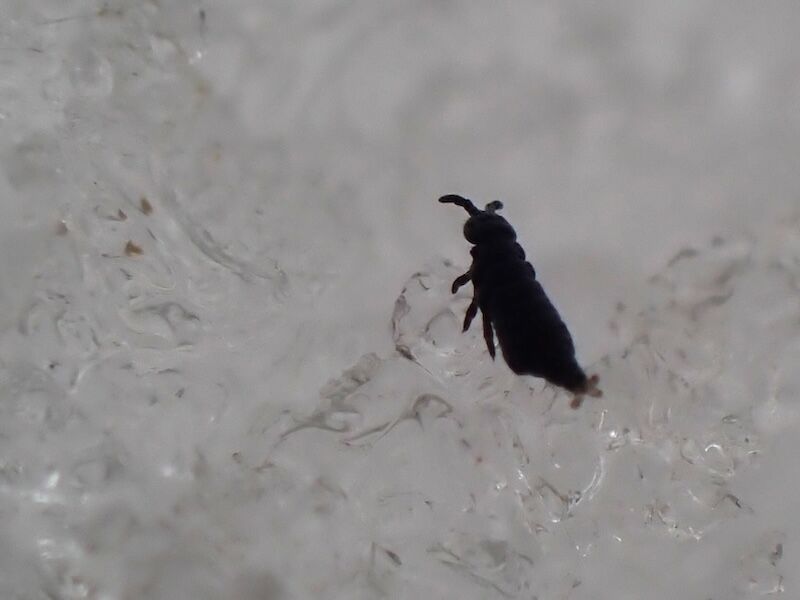With soggy skies above and soggy snow below, my recent hike on the North Country Trail was not inspiring a love for spring. But with my head bent to watch my footing, I noticed a sprinkling of debris coated the surface of the softening snow. Suddenly one of the little specks vanished. Crouching down for a better look, I discovered that most of the sprinkles were tiny, leaping springtails known as snow fleas. I dug out my macro camera.
While springtails have six legs, they aren’t insects. Instead, they belong to the insects’ sister group with several different characteristics. A lack of wings, simple instead of compound eyes, differences in molting, a special mouthpart for drinking, and a hinged body part that can fling them into the air set springtails apart from true insects.
A springtail’s namesake spring is a forked appendage called a furcula, made from two modified legs on their final body segment. In my research, I found photos of two-pronged furculae, but in the photos and videos I captured of these little beings, the furcula has three prongs.
While resting, a springtail locks the prongs of their furcula up against their belly, thereby storing potential kinetic energy in their abdominal muscles. A rubber-like protein called resilin in the springtail’s exoskeleton helps to flex and store energy, too. The whole system is similar to an upside-down mouse trap.
When the springtail is startled by a potential predator, such as a giant human hiker, they release the clasp and the furcula snaps open against the ground. The being launches into the air, as far as 100 times their one-eighth-inch body length! This explanation, summarized from a variety of sources, makes me think that it would be impossible to see the furcula before the springtail goes flying. However, my videos show the furcula expanding from the springtail’s rear end for a second before they disappear. Check out the Cable Natural History Museum’s Facebook and Instagram Reels for video highlights!
After an uncontrolled flight, a springtail might land mere inches from their starting point, which is still far enough to fool many of their predators—like ants, beetles, and salamanders. Post fling, springtails don’t always land on their feet. Luckily, they have a neat trick for righting themselves. Two inflatable grooming tools not only help them to keep clean, the sticky tubes can be adhered to the ground and used to pull the springtail upright.
While springtails are in the running to be the most abundant of all macroscopic animals (you might find 100,000 individuals in a square meter of soil, and there are about 3,600 species total), we typically only notice the one or two species who spend time on the surface of snow. Snow fleas get their name from their jumpy behavior and the substrate that makes them visible.
On balmy winter days, snow fleas scatter like pepper over the surface of the snowpack, or they might congregate in crawling hordes of a million individuals, drawn together by pheromones for a mating party. It’s amazing that such a tiny being can survive at all in the frozen expanse of snow. The magic that makes this possible is a unique protein especially rich in the amino acid glycine. This protein binds to ice crystals as they start to form, preventing them from growing larger, and so it acts as an antifreeze. The protein works down to about 21°F, and at warmer temperatures it disappears! Doctors are studying its potential to help preserve human organs on their way to a transplant surgery.
Snow fleas don’t really spend much of their life on top of the snow. Like other springtails, they inhabit the soil and leaf litter. Other species of springtails (not snow fleas) live in tree canopies and even on top of water. A moist environment is essential to prevent desiccation. Since they breathe directly through their skin (another difference from insects, who use a trachea), springtails must balance hydration with breathing. Complex structures on their skin trap tiny, durable reservoirs of air.
In their damp habitats, springtails are essential members of the community. What they lack in size, they make up for in numbers. They fragment organic material and make it easier for decomposers to break down. Springtails also curate the soil’s microbial inhabitants by eating bacteria and fungi, and by spreading them around. One common fungus—Laccaria bicolor—has turned the tables on springtails. This fungus paralyzes and decomposes the springtails, then sends their nitrogen over to a white pine through their roots.
On your next adventure in the snowy woods, be sure to keep an eye out for tiny, leaping specks on the snow. They just might be more interesting than you’d expect!
Author’s Note: This article has been updated from 2016. I’m busy building an exhibit!
Emily’s award-winning second book, Natural Connections: Dreaming of an Elfin Skimmer, is available to purchase at www.cablemuseum.org/books and at your local independent bookstore, too.
For more than 50 years, the Cable Natural History Museum has served to connect you to the Northwoods. The Museum is closed until May 1 to construct our new exhibit: “Anaamaagon: Under the Snow.” Our Summer Calendar of Events is open for registration! Follow us on Facebook, Instagram, YouTube, and cablemuseum.org to see what we are up to.
Last Update: Apr 10, 2024 10:22 am CDT
















